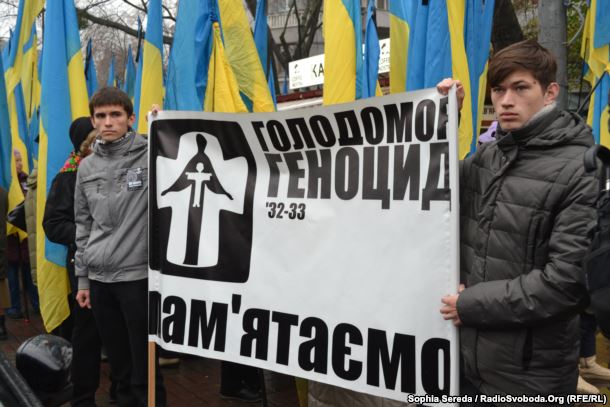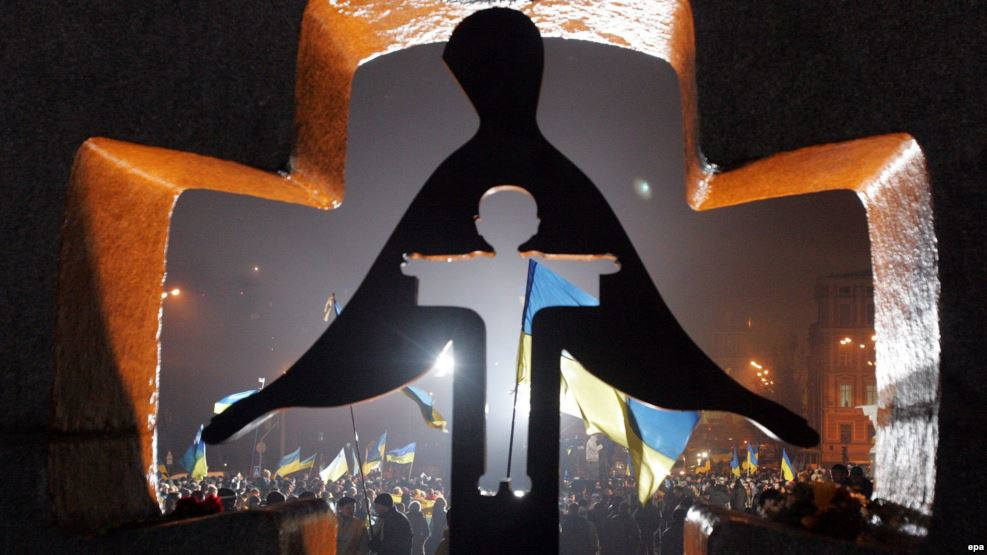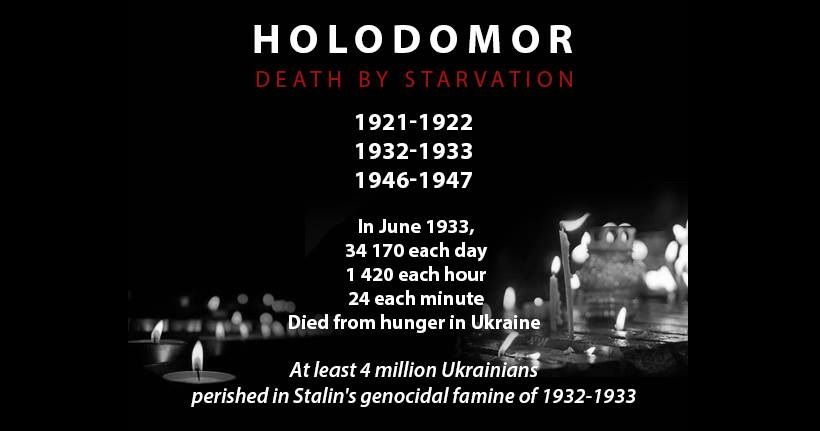The memory of Holodomor entered the Ukrainian national consciousness only during the perestroika years. It is difficult to imagine now, but the communist regime succeeded in hiding the fact that the mass murder had been planned from its own citizens, even from those who had lost loved ones during the Holodomor years, even from those who had lived through the famine themselves. The curtain on the scene of the Stalinist crimes rose slowly and reluctantly. People began to talk about the murder of Soviet citizens only in the late ’50s and the early ’60s of the past century, after the appearance of Nikita Krushchev, the First Secretary of the Central Committee of the Communist Party of the Soviet Union, at the 20th Party Congress. As a sinister irony of fate, the rehabilitated party leaders included the direct participants and organizers of the Holodomor: Stanislav Kosior, Pavel Postyshev, Vlas Chubar, Panas Lyubchenko. Miraculously, the former formal head of Soviet Ukraine, the sinister torturer Grigory Petrovsky, survived. And during these years of Communist rule, he even received the title of Hero of Socialist Labor, becoming the canonical “Senior Bolshevik.”
Public opinion has accepted the view that Soviet security forces on the orders of Stalin and other thugs from the Bolshevik leadership had organized mass repressions against the people. Anyone who tries to deny that these repressions took place is now viewed as an exception. Even Stalin’s followers do not deny these repressions; they simply talk about their inevitability, trying to justify their bloody idol.
Much less is said about the organization of the Great Famine than about the Great Terror. In the mind of the average Soviet resident, the famine has been associated with the consequences of the civil war and the economic policies of the Bolshevik leadership. The fact that is was organized deliberately to murder hundreds of thousands of people is not part of general consciousness up to this day. People find it especially difficult to believe that this famine could have been organized for a specific purpose — the destruction of ethnic and social groups, as happened during the Holodomor. It is strange that the same people who know about the deliberate expulsion by the Stalin regime of the peoples of the Caucasus or the Crimean Tatars — on the basis of their nationality — do not believe that the policy of the Bolshevik Central Committee could be directed specifically against Ukrainians. The first big lie in the perception of Holodomor lies in this unwillingness to see and acknowledge obvious facts.
The core motivation: fear of the Ukrainian people
But there is one big lie that perhaps is even more dangerous than the first. Because this second lie regards not the Russian or the Communist versions of what happened on Ukrainian lands in the ’30s. This second lie is tied to the perception of what happened by the Ukrainians themselves, and even by the leadership. If you ask the average person why Stalin decided to destroy Ukrainians, he is unlikely to tell you that the Communist leader feared them. People will talk about the desire to drive the peasants into collective farms, to provide bread for the cities, to obtain grain to sell abroad. They will mention the brutal logic of class warfare, which was driving the Bolshevik repression. In this interpretation, millions of Ukrainian peasants, destroyed by Stalin and his sycophants, will appear as the innocent victims of repression, who represented no threat to Bolshevism and were simply murdered by their rulers.
But this is not at all the reality that defined the Holodomor. The truth is that it was Stalin’s fear. It was this fear of the Ukrainian people that was the main motive that determined the dictator’s actions.
When Stalin wrote to his collaborators that “we may lose Ukraine,” he was by no means expressing a paranoid suspicion. Stalin’s own analysis of future developments in Ukraine is revealing. His letter to Kaganovich about the possibility of losing Ukraine was dated August 11, 1932. From our modern perspective, Stalin had been ruling the Soviet Union for many years. But this was not the case at all. Alexei Rykov resigned as chairman of the Council of People’s Commissars of the Soviet Union only in December 1930, when he was replaced by Stalin’s ally Vyacheslav Molotov. This is the date that marks the beginning of Stalin’s absolute power. In 1931 Stalin began constructing his own empire. Unlike other Soviet leaders, he was an expert on the national question, having served as the first nationalities commissar in the Soviet government. He could not fail to remember that the Bolsheviks had established control over Ukrainian lands only a decade earlier, after a bloody war. And this was not a civil war as in Russia. This was a war of the Russian Red Army and its henchmen in Ukraine against Ukrainians. If one is to use the modern political vocabulary, it was a war against Ukraine with the help of the “Donetsk People’s Republic.” Only then the “Donetsk People’s Republic” won.
Stalin knew that most Ukrainians had never supported the Bolsheviks. That the population of the large cities during the elections to the Russian Constituent Assembly had voted for different political parties in the Russian Empire but not for the Bolsheviks. And that the Ukrainian village population supported the same Ukrainian national parties that had declared the Ukrainian National Republic. These people that formed the electoral basis for renewing the Ukrainian state were still alive and wanting to work on their land. And, despite heavy losses during the Bolshevik occupation, they had not been broken.
Stalin was convinced by a series of peasant uprisings that were a response to the policy of collectivization. Any awareness of these uprising was carefully concealed by the regime. Even the possibility of an uprising and victory over authoritarianism is its greatest defeat. It is not by accident that Nazis razed to the ground the Sobibor concentration camp where the prisoners had defeated the SS. Afterwards, the Soviet authorities ignored the success of this uprising for years. The logic of both the Stalin and Hitler regimes was that evil cannot be overcome and power cannot be resisted. This is what they were protecting. This is why they were hiding the truth.
Yes, it is possible that these uprisings cannot be viewed as having been carefully organized; most of them were a social phenomenon. They were a protest against the policy of collectivization and the barbaric “grain procurement.” After all, the organized centers of peasant resistance had been destroyed after the Bolshevik occupation still in the early ’20s. But the fact that even after this terrible reprisal in Ukraine there were still thousands of people who were ready to oppose the regime could not fail to frighten Stalin. Holodomor was his conscious decision to destroy the Ukrainian village as a political and civilizational foundation of the Ukrainian nation. The fact that the village was the first to undergo the attack was completely natural. The journalists of the time wrote about the invincibility of the Ukrainian peasant. An example was the excellent article written by the future ideologue of Zionism, the Odesa writer Vladimir Zhabotinsky (Ze’ev Jabotinsky). They were convinced that the peasant would outlive all his oppressors, all those who encroach on the very foundations of his existence, on the structure of Ukraine, on its values.
Stalin decided to conquer this peasant. He decided to starve him to death. To destroy him. As long as this peasant was alive and ready to fight, the Bolshevik dictator could not be sure of his power over Ukraine. And in the certainty that his empire would last.
Stalin did not win, but the blow was devastating. It was this blow that brought about the civilizational shock that has affected millions of people. That led to the disappearance of Ukrainian life for many long years, even decades. That generated the fear of everything Ukrainian, of the peoples’ own historical memory. This blow was one of the important components of the political heritage of modern Ukraine. This is what is keeping the country from moving forward. This is what up to this day has allowed two identities to exist in one country — the Ukrainian identity and the Soviet one. And moreover, the second identity is one of fear.
This was a blow to the enemy

But at the same time it must be understood that Stalin’s blow was not a blow against innocent victims that were ready to accept his cannibalistic policies. No, it was a blow against the enemy. It was a blow against the people who were ready to fight back and who were capable of rebelling. I have no doubt that as historians begin to concentrate on the era of the ’20s and ’30s they will find more direct confirmation of this readiness to resist.
Since time immemorial Ukrainians have been a rebellious people. The rejection of evil, the readiness to resist, marked the very development of Ukrainian civilization during the era of the Republic of Poland as well as during the Tsardom of Russia and the Russian empire. The perception of Ukrainians as a rebellious people became the main theme in the works of Taras Shevchenko and marked the creative self-awareness of his readers — the Ukrainian people themselves. And years after the collapse of the Russian Empire, there has been a continuous wave of uprisings and a readiness to confront oppressors even when the oppressor is much stronger.
For Stalin as well, the Ukrainians were also a rebellious people. This is precisely what he wanted to destroy — their will to rebel. This is why the Holodomor took place. This was not only the desire to take away bread. This was the desire to steal the heart and will. And despite the millions of victims, this is precisely what Stalin and his successors have failed to do. They took away the bread, but they could not take away the heart and will.
Even after the most terrible trial in their national history, the Ukrainians remained a rebellious people. Events during the recent decades of national history–the two Maidans, the national war against Russian invaders– attest to that with complete clarity. If Stalin had magically appeared among us on during the Maidan of 2013-2014, if he had seen the descendants of those he had tried to starve to death, he would have realized that he had lost irreparably.








